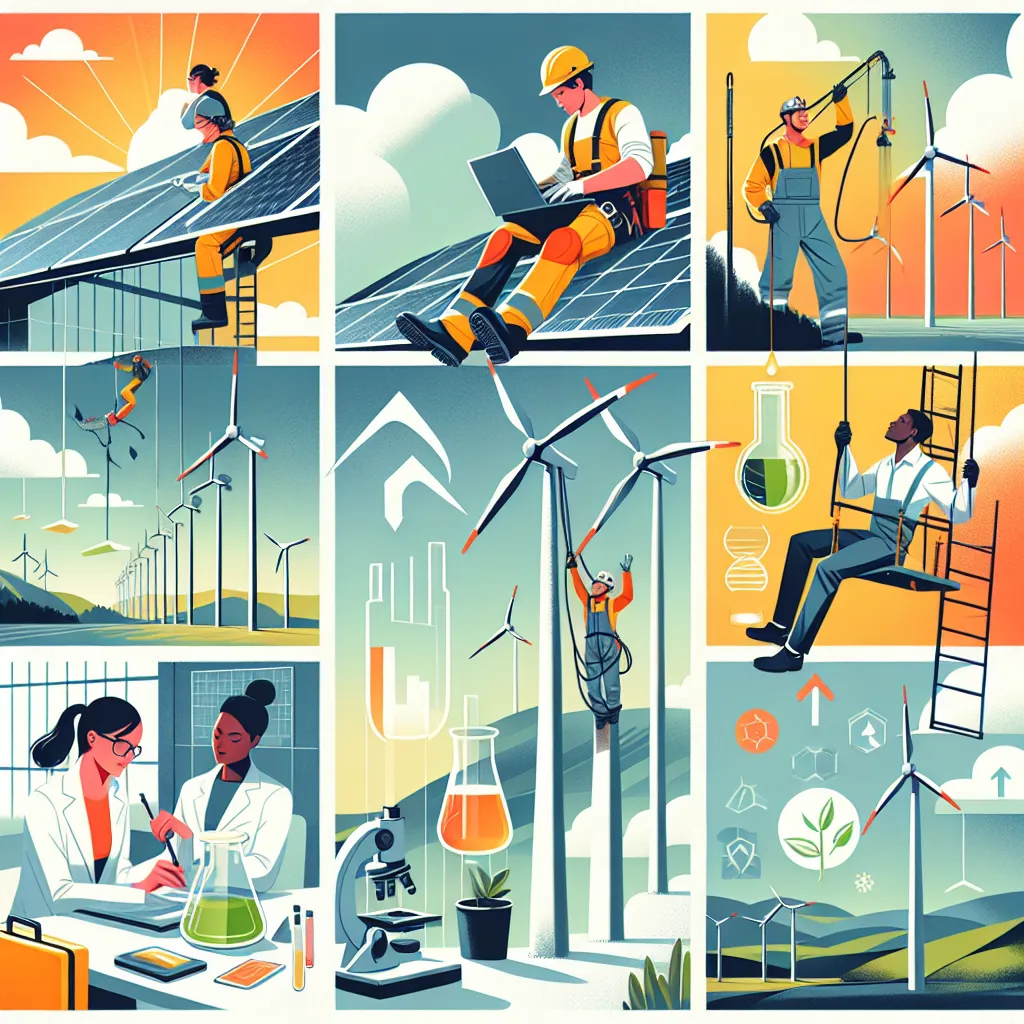Welcome to our IELTS Reading practice test focused on the topic “How Renewable Energy is Driving Job Creation”. This test is designed to help you prepare for the IELTS Reading section by providing a realistic exam experience with passages and questions that mirror the actual test. As you work through this practice test, you’ll not only improve your reading skills but also gain valuable insights into the growing field of renewable energy and its impact on employment.
Nội dung bài viết
 Renewable Energy Jobs
Renewable Energy Jobs
Reading Passage 1
The Green Job Revolution
The transition to renewable energy is not just an environmental imperative; it’s becoming a major driver of economic growth and job creation worldwide. As countries strive to reduce their carbon footprint and achieve energy independence, the renewable energy sector is experiencing unprecedented expansion, leading to a surge in employment opportunities across various industries.
In recent years, the renewable energy sector has outpaced fossil fuel industries in job creation. According to the International Renewable Energy Agency (IRENA), the sector employed 11.5 million people globally in 2019, a significant increase from 7.3 million in 2012. This growth is expected to continue, with projections suggesting that renewable energy could employ more than 42 million people by 2050.
The solar photovoltaic (PV) industry has been particularly prolific in generating jobs. As the cost of solar panels has plummeted and efficiency has improved, solar installations have skyrocketed, creating a demand for workers in manufacturing, installation, and maintenance. Similarly, the wind energy sector has seen substantial job growth, especially in offshore wind farms, which require specialized skills and create opportunities in coastal communities.
But it’s not just about direct jobs in renewable energy production. The shift towards clean energy is creating a ripple effect across the economy. For instance, the electric vehicle industry, closely tied to renewable energy, is booming, creating jobs in manufacturing, charging infrastructure, and battery technology. Moreover, the need for energy-efficient buildings is driving demand for green construction workers and energy auditors.
Importantly, renewable energy jobs are often more geographically dispersed than those in fossil fuel industries. While traditional energy jobs are typically concentrated around fossil fuel deposits or large power plants, renewable energy jobs can be found in both urban and rural areas, helping to revitalize communities that may have been left behind by other economic trends.
However, the transition to a green economy is not without challenges. Many fossil fuel workers will need to be retrained and reskilled to take advantage of new opportunities in renewable energy. Governments and businesses must work together to ensure a just transition, providing support and training programs to help workers adapt to the changing energy landscape.
As we look to the future, it’s clear that renewable energy will play a crucial role not just in combating climate change, but in shaping the global job market. The green job revolution is underway, offering exciting opportunities for workers across a wide range of skills and backgrounds.
Questions 1-7
Do the following statements agree with the information given in Reading Passage 1? Write
TRUE if the statement agrees with the information
FALSE if the statement contradicts the information
NOT GIVEN if there is no information on this
- Renewable energy job growth has been slower than in fossil fuel industries.
- The International Renewable Energy Agency predicts over 40 million renewable energy jobs by 2050.
- The solar photovoltaic industry has created the most jobs in the renewable energy sector.
- Offshore wind farms require workers with specialized skills.
- The electric vehicle industry is creating jobs only in manufacturing.
- Renewable energy jobs are more evenly distributed geographically compared to fossil fuel jobs.
- All fossil fuel workers will easily transition to jobs in the renewable energy sector without retraining.
Questions 8-13
Complete the sentences below. Choose NO MORE THAN TWO WORDS from the passage for each answer.
- The renewable energy sector employed ___ million people globally in 2019.
- The cost of ___ has significantly decreased, leading to more solar installations.
- The growth of renewable energy is creating a ___ effect across the economy.
- The need for ___ is increasing demand for green construction workers.
- Renewable energy jobs can help ___ communities that may have been economically disadvantaged.
- Governments and businesses must ensure a ___ to help workers adapt to the new energy economy.
Reading Passage 2
The Skills Gap in Renewable Energy
As the renewable energy sector continues to expand rapidly, a growing concern has emerged: the skills gap between the workforce needed and the workers available. This mismatch between supply and demand in the labor market poses a significant challenge to the industry’s growth and could potentially slow down the transition to clean energy.
The renewable energy sector requires a diverse range of skills, from highly technical engineering roles to installation and maintenance positions. However, the rapid pace of technological advancement in the field means that the required skill sets are constantly evolving. This dynamic environment creates a situation where educational institutions and training programs struggle to keep up with the industry’s needs.
One of the most acute shortages is in the area of skilled technicians for wind and solar energy systems. These roles require a unique blend of electrical, mechanical, and safety skills, often combined with the ability to work at heights or in remote locations. The Global Wind Organisation (GWO) has highlighted the need for standardized safety and technical training to address this shortage and ensure a competent workforce.
In the solar industry, the demand for qualified installers has skyrocketed as residential and commercial solar adoption increases. The North American Board of Certified Energy Practitioners (NABCEP) provides certifications for solar professionals, but the number of certified installers is struggling to keep pace with market growth.
The skills gap is not limited to technical roles. The renewable energy sector also faces shortages in areas such as project management, data analysis, and regulatory compliance. As projects become larger and more complex, especially in offshore wind, there’s a growing need for professionals who can navigate the intricate planning and execution processes.
To address this skills gap, a multi-faceted approach is necessary. Vocational training programs and apprenticeships are crucial for developing the practical skills needed in installation and maintenance roles. Universities are increasingly offering specialized degrees in renewable energy, but there’s a need for even greater collaboration between academia and industry to ensure curricula remain relevant.
Reskilling programs for workers from adjacent industries, particularly those from the fossil fuel sector, can help bridge the gap. Many skills from traditional energy jobs are transferable to renewable energy with some additional training. For instance, offshore oil and gas workers often have valuable experience that can be applied to offshore wind projects.
Governments have a role to play as well. Policy initiatives that support workforce development in the renewable energy sector can help create a pipeline of skilled workers. This could include funding for training programs, incentives for businesses to provide apprenticeships, and integration of renewable energy topics into STEM education at earlier stages.
The renewable energy industry itself is also taking proactive steps. Many companies are investing in in-house training programs and partnerships with educational institutions. Some are even using virtual and augmented reality technologies to provide immersive training experiences that can accelerate skill development.
Addressing the skills gap is crucial not only for the growth of the renewable energy sector but also for maximizing its potential for job creation. By ensuring a skilled workforce is available, we can fully harness the economic benefits of the transition to clean energy while meeting our climate goals.
Questions 14-19
Choose the correct letter, A, B, C, or D.
-
The main challenge to the growth of the renewable energy industry is:
A) Lack of funding
B) Technological limitations
C) Skills gap in the workforce
D) Government regulations -
According to the passage, which area faces one of the most severe shortages of skilled workers?
A) Solar panel manufacturing
B) Wind and solar energy system technicians
C) Renewable energy research
D) Energy policy development -
The Global Wind Organisation (GWO) emphasizes the need for:
A) More wind farms
B) Higher salaries for wind energy workers
C) Standardized safety and technical training
D) International collaboration in wind energy -
In the solar industry, there is a high demand for:
A) Solar panel designers
B) Qualified installers
C) Marketing professionals
D) Solar farm managers -
The skills gap in renewable energy is:
A) Only in technical roles
B) Mainly in management positions
C) In both technical and non-technical roles
D) Not significant compared to other industries -
Which of the following is NOT mentioned as a way to address the skills gap?
A) Vocational training programs
B) University degrees in renewable energy
C) Reskilling programs for fossil fuel workers
D) Reducing the number of renewable energy projects
Questions 20-26
Complete the summary below. Choose NO MORE THAN TWO WORDS from the passage for each answer.
The renewable energy sector is facing a significant (20) as the industry grows rapidly. This issue affects various roles, from technical positions to (21) jobs. Organizations like the Global Wind Organisation and the North American Board of Certified Energy Practitioners are working to address shortages in their respective fields. To tackle this problem, a multi-faceted approach is needed, including (22) and apprenticeships for practical skills, specialized university degrees, and greater collaboration between (23) and industry. (24) for workers from related industries, especially the fossil fuel sector, can also help. Governments can support through policy initiatives, while the industry is investing in (25) and partnerships with educational institutions. Some companies are even using (26) ___ technologies to provide immersive training experiences.
Reading Passage 3
The Global Impact of Renewable Energy Jobs
The surge in renewable energy jobs is not just a localized phenomenon; it’s reshaping labor markets and economies on a global scale. This transformation is particularly significant in developing countries, where renewable energy projects are often leapfrogging traditional energy infrastructure and creating new pathways for economic development.
According to the International Labour Organization (ILO), the transition to a greener economy could create 24 million new jobs globally by 2030. However, the distribution of these jobs is not uniform across regions or technologies. Asia, for instance, has emerged as a powerhouse in renewable energy employment, with China leading the way. The country’s dominance in solar PV manufacturing and installation has created millions of jobs, while also driving down the global cost of solar technology.
In India, the government’s ambitious renewable energy targets have spurred significant job creation. The country’s National Solar Mission aims to deploy 100 GW of solar power by 2022, a goal that has already generated hundreds of thousands of jobs in solar panel manufacturing, installation, and maintenance. Moreover, India’s decentralized renewable energy sector, which includes off-grid and mini-grid solutions, is providing employment opportunities in rural areas where job prospects were previously limited.
Africa presents a unique case study in the global renewable energy job market. The continent’s vast renewable resources, coupled with its need for increased energy access, create a fertile ground for green job growth. Countries like Kenya and Morocco are at the forefront of this trend. Kenya’s geothermal industry has become a significant employer, while Morocco’s Noor Ouarzazate Solar Complex, one of the world’s largest concentrated solar power plants, has created thousands of jobs and is serving as a model for other African nations.
In Latin America, Brazil stands out for its long-standing commitment to renewable energy, particularly in the biofuels sector. The country’s sugarcane ethanol industry supports over 800,000 jobs, demonstrating how agricultural practices can be integrated with renewable energy production to create sustainable employment.
The Middle East, traditionally reliant on fossil fuels, is also pivoting towards renewable energy. The United Arab Emirates and Saudi Arabia are investing heavily in solar projects, not only to diversify their economies but also to create high-skilled jobs for their young populations. These initiatives are part of broader economic transformation plans aimed at reducing dependence on oil revenues.
In Europe, the offshore wind sector has become a major employer, particularly in countries bordering the North Sea. The UK, Germany, and Denmark are leading this charge, with projects creating jobs not only in turbine manufacturing and installation but also in specialized maritime roles.
The United States has seen significant job growth in the solar and wind sectors, with solar jobs outnumbering those in coal in many states. However, the distribution of these jobs varies widely, with some regions benefiting more than others. This uneven distribution highlights the need for targeted policies to ensure a just transition for communities historically dependent on fossil fuel industries.
It’s important to note that the quality of jobs in the renewable energy sector varies. While many positions offer high wages and good working conditions, particularly in developed countries, there are concerns about labor standards in some parts of the global supply chain, especially in manufacturing.
The growth of renewable energy jobs also has secondary effects on local economies. These jobs often create additional employment through the multiplier effect, supporting roles in supply chains, services, and local businesses. Furthermore, community-owned renewable energy projects are emerging as a model that can keep economic benefits local while also creating jobs.
As the renewable energy sector continues to grow and evolve, it’s clear that its impact on global employment will be profound. However, realizing the full potential of this job creation will require coordinated efforts from governments, industry, and educational institutions to ensure that workers have the skills needed to succeed in this rapidly changing field. The transition to renewable energy represents not just an environmental imperative, but a significant opportunity to create sustainable, quality jobs across the globe.
Questions 27-32
Choose the correct letter, A, B, C, or D.
-
According to the International Labour Organization, how many new jobs could be created globally by 2030 due to the transition to a greener economy?
A) 11.5 million
B) 24 million
C) 42 million
D) 100 million -
Which country is mentioned as a leader in solar PV manufacturing and installation?
A) India
B) United States
C) Germany
D) China -
What is the target for solar power deployment in India’s National Solar Mission by 2022?
A) 24 GW
B) 42 GW
C) 100 GW
D) 800 GW -
Which renewable energy sector is particularly significant in Brazil?
A) Solar power
B) Wind energy
C) Biofuels
D) Geothermal energy -
In which region is the offshore wind sector becoming a major employer?
A) Middle East
B) North America
C) Europe
D) Southeast Asia -
What concern is mentioned regarding renewable energy jobs in some parts of the global supply chain?
A) Lack of skilled workers
B) Low wages
C) Labor standards
D) Job security
Questions 33-40
Complete the sentences below. Choose NO MORE THAN THREE WORDS from the passage for each answer.
- The distribution of renewable energy jobs is not ___ across regions or technologies.
- In India, the decentralized renewable energy sector is providing job opportunities in ___ areas.
- Kenya’s ___ industry has become a significant employer in Africa’s renewable energy sector.
- The Noor Ouarzazate Solar Complex in Morocco is serving as a ___ for other African nations.
- Middle Eastern countries are investing in renewable energy to reduce dependence on ___.
- In the United States, ___ jobs now outnumber coal jobs in many states.
- Community-owned renewable energy projects can keep ___ local while creating jobs.
- Realizing the full potential of renewable energy job creation requires coordinated efforts from governments, industry, and ___.
Answer Key
Reading Passage 1
- FALSE
- TRUE
- NOT GIVEN
- TRUE
- FALSE
- TRUE
- FALSE
- 11.5
- solar panels
- ripple
- energy-efficient buildings
- revitalize
- just transition
Reading Passage 2
- C
- B
- C
- B
- C
- D
- skills gap
- project management
- vocational training programs
- academia
- Reskilling programs
- in-house training
- virtual and augmented reality
Reading Passage 3
- B
- D
- C
- C
- C
- C
- uniform
- rural
- geothermal
- model
- oil revenues
- Solar
- economic benefits
- educational institutions
This IELTS Reading practice test on “How Renewable Energy is Driving Job Creation” provides a comprehensive overview of the global impact of renewable energy on employment. It covers various aspects such as the skills gap in the industry, regional differences in job creation, and the challenges and opportunities presented by this growing sector.
For IELTS test-takers, this practice test offers valuable experience in dealing with different question types commonly found in the IELTS Reading section. It includes True/False/Not Given, sentence completion, multiple choice, and summary completion questions, which are all typical of the actual IELTS test.
To excel in the IELTS Reading test, remember to:
- Skim the passages quickly to get a general idea before answering questions.
- Pay attention to keywords in both the passages and questions.
- Practice time management, as you’ll have limited time in the actual test.
- For True/False/Not Given questions, be careful not to infer information that isn’t explicitly stated in the text.


